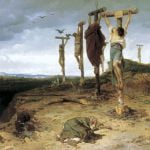Archimedes was a brilliant Greek scientist who led engineering work to defend Syracuse during the second Punic war, in 214-212 BCE. The Romans storming the massive city walls had to deal with unusual Archimedes inventions, including mirrors!
Roman troops have tried many attacks from the sea. Archimedes came to the conclusion that by using several mirrors arranged in such a way that the reflected sun’s rays hit one point on the ship, he would be able to heat the wood to such an extent that fire would appear. This event is described by Lucian of Samosata – a Roman historian from the 2nd century CE – in the work “Dialogues of the Dead” claiming that the method proved effective and many ships were destroyed.
To this day, there are agonizing, which was the aforementioned mirrors and allowed the reflection of sunlight. A suggestion is, for example, bronze or copper shields that focused the rays. To this end, the Greek scientist Ioannis Sakkas conducted an experiment in 1973 near Athens. 70 mirrors (with copper coating) were used, each 1.5 by 1 meter, which were set so that the light beam accumulated at a given point, located at a distance of 50 meters, of a model of a Roman warship. In a few seconds there was a fire, It is worth mentioning that the ship (like antique) had a coating of tar/wax, which could support fire susceptibility.
Interestingly, in 2010, the popular program “Mythbusters” used 500 mirrors to set fire to a Roman ship at a distance of 120 m. However, researchers failed to set fire to the wood and it was considered that the light could be used to dazzle the ship’s crew.







